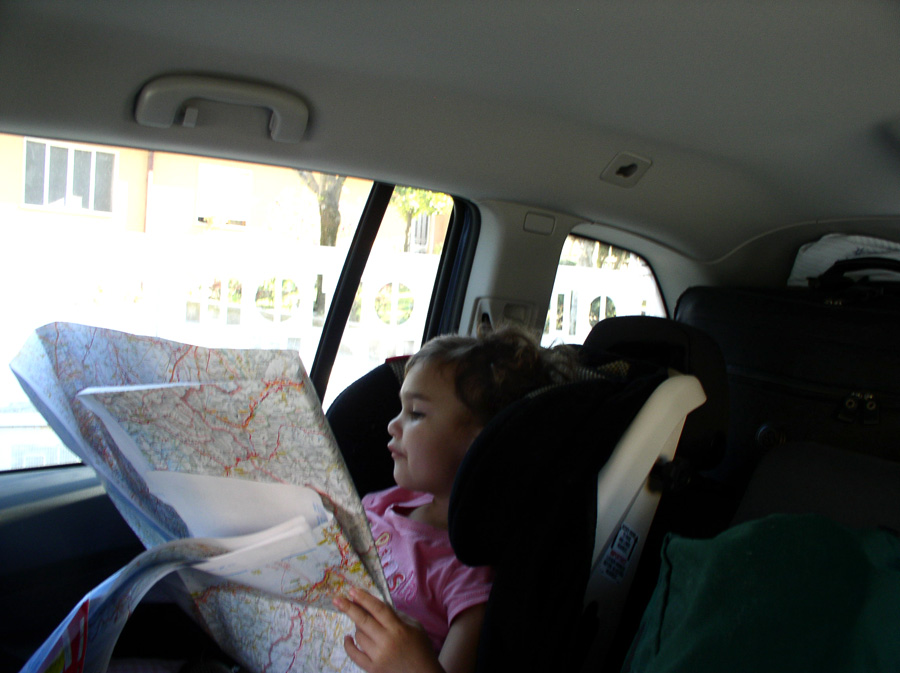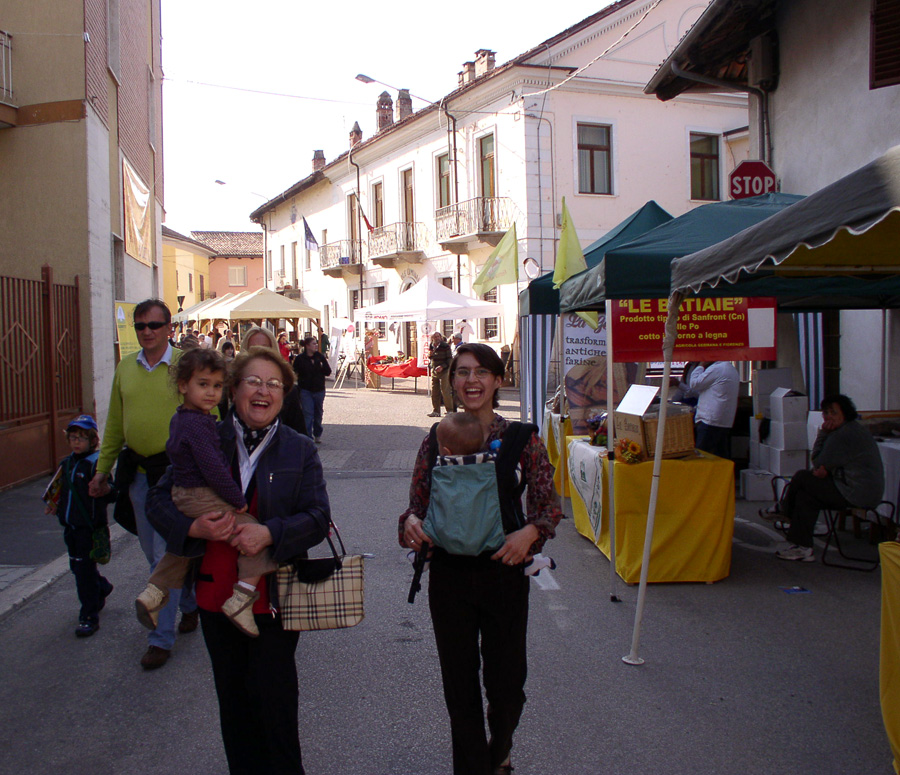| |
| |
We are in Italy. Our first adventure (after over 24 hours of airplanes and airports) was our rental car. We packed all our seventeen (more or less) bags into it and set off, map in hand. We had gotten almost out of the airport parking lot when the car began to smell bad. And then worse. We turned around and headed back, concerned. A passerby flagged us down, pointing to the engine, from which smoke was beginning to billow. Tony parked the car and rushed back in to the car rental place. I was still sitting in the car with the children when a man came up to the window and said I should get out, and asked me where my husband was, and said the car was on fire. I unbuckled the children and got out. Another person motioned us away from the car. Apparently, it was brand new and had been shipped without oil. They replaced the car and we transferred our belongings and set off again for our hotel.
At the critical juncture, we took a wrong turn, and ended up driving around Turin for hours and hours. We finally made it to our hotel late that evening. The next morning, we headed out to Lagnasco, the little town where Domenico was born. Following the directions given us at the hotel, we stayed on the road toward Savona through several toll booths. We hadn't changed much money, and we began to be concerned that we would run out of cash just from continuing to drive. We finally pulled over at a gas station and were told that we had overshot the city and would need to turn around. We thought about just driving back to Turin, where we knew we could change money. But we decided to forge ahead.
We stopped in a little town and asked someone where the banco was. She looked confused, and began to ask clarifying questions. I got out the sentence from the guidebook about how I needed to change money. "Ah, la banca," she exclaimed, and directed us just down the street. Of course, by this time it was 1:30. Lunch in Italy lasts till 2:30 or 3:00, and everything is closed until afterward. We waited till the bank opened, changed our money, and then were back on our way.
We arrived in Lagnasco late in the afternoon. Driving up, it was surrounded by thousands of fruit trees, all arranged in perfect rows and just coming into bloom. We drove into the tiny town square and looked around in wonder. It was like a village out of a storybook. The streets and sidewalks were spotless. The houses had quaint wooden shutters, intricate metal porches, and red-tiled roofs. In the center of town was a lovely old church with a bell-tower that chimed the hour. We walked around, imagining what it would be like to live there, and then drove home.
Next day was Saturday, which we spent driving up and down Soviet Union Street in Turin and trying to get internet. Sunday we went to Church, where the branch welcomed us warmly and made us all feel very much at home. We love Italy. It is a beautiful, friendly, and amazing place.
A few days later we drove to Melle, where the Bodrero family originates. As we drove farther from Torino, the towns got smaller and smaller, and the little church in the center of each seemed more and more ancient. Finally, as we wound up toward the Western hills at the foot of the Alps, we passed into the town of Melle. The boroughs of the town climb up into the very tops of the hills, reaching a stillness broken only by birdsongs. The little green meadows are sprinkled with tiny, delicate butter-yellow flowers.
Through the town center and up a little winding hill is the borough of the Bodreros - a little cluster of centuries-old stone houses with shale roofs and tidy little gardens. A kind gentleman answered our questions and made us feel welcome. He was not a Bodrero himself, but he pointed out for us the houses of the Bodreros. When we asked if we could take a photograph, he graciously allowed us, and even took a few for us. As we drove down in the twilight, we thought about why and how they would have moved to Lagnasco. How they would have even heard, from up on their mountaintop, of an equally little town down in the valley, and just picked up and left. Perhaps when we know Italian history a little better we'll be able to divine some historical reason for their move. Or maybe they just got tired of eking out a living on the mountain and came down to the fertile plain to farm somewhere they didn't have to carve terraces out of the hill to plant a few rows of crops.
Our next visit was to the Waldensian Valleys. We took our course northwest from Torino and drove up and up and up, higher than Melle, into Angrogna. There, we parked the car and walked down a path to a place where the mountain's bones are exposed and broken in pieces. This was the Cave Church. A little path led off the main path, and we walked down to a tall jumble of rocks, hiding the small opening. It's difficult to imagine climbing in there, let alone bravely singing hymns while hiding as fugitives from the prevailing authorities. Grandpa Bringhurst would have said, "let's sing!" And we did. We sang "For the Strength of the Hills," also named "The Hymn of the Vaudois Mountaineers in Times of Trouble." It was a humble and awe-inspiring experience to stand on what for them was, and for us is because of them, holy ground.
Off in the distance from Torre Pellice, you can see Casteluzzo, the outcropping of rock that looks like a "little castle." Having seen so many real castles perched on hills here in Piedmont, we can see that its name is no more fanciful here than Chimney Rock is in Utah. As we drive through the countryside, we picture how here, or there, we will remodel our own little house in Italy, our own Casteluzzo. At Torre Pellice also is the main Waldensian Museum, chronicling their long historic struggle to maintain their faith in the face of every adversity.
Our (and our relatives') efforts at procuring lodging in Lagnasco having proved vain, and having discovered that there are neither busses nor reliable internet in Lagnasco, we decided to move to Saluzzo, the largest neighboring town. We've been staying there anyway, and falling by degrees in love with it. The town is built right up against the hills, on the edge of the fertile plain. The beautifully preserved but still very much alive old city winds up the hill, culminating in its own castle, currently under renovation. We found a beautiful little apartment right in the middle of it, cobblestone streets, painted frescoes, and spacious vaulted ceilings and all. The icing on the cake is that it's less than a third of our rent in San Diego (at one of the many San Diego apartment communities that try to look Italian).
We took back our rental car and replaced it. Our family vehicle is now a tandem stroller. We tried it on the steep cobblestone hills of Old Saluzzo the other day, and it worked beautifully.
|
|

Richard Boudrero took a
trip 2 years ago and
discovered the Bordrero
relatives still living in
Lagnasco, Italy |

The long trip to Italy |

|

|

|

notice "Bodriri" on the sign
in Melle pointing to the
original homes of our
ancestors high up in the
meritime alps |

an old home in Melle |

one of the original (probably
some 500 years old) Bodriro
homes in Melle |

|

|

driving through wine country |

Axa with a glow stick |

the "play area" at the hotel |

Anna and Beppe Bodriro |

"Fruit In Fiori" festa in Lagnasco |

the Waldensian headquarters
with "Casteluzzo" (the rock of
prophecy) in the background (the
hump on the mountain right
above the yellow steeples) |

|

The castle church |

cruising the cobblestone
streets in Saluzzo in style |

|

Saluzzo |

royal blood of Casa Cavasa
(the ruling family) in Saluzzo |

notice the calsified mineral
deposits on the top of
the fountain...this fountain has
been going for a LONG TIME |

Saluzzo's castle |

|

buying bread from our
favorite bread shop |
|
|
|
|
|